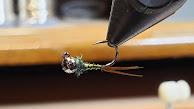After a recent weekend in which I had the rare opportunity to fly fish for trout on two consecutive days, I was left with two vastly different experiences and plenty to think about: the type of trout I caught, the challenges (or lack thereof) they presented, and the rewards (or lack thereof) of netting them. Yes, I’m talking about wild trout, native trout, and stocked trout, but not in a way that’s judgmental of anglers who target any of the three types; my goal is simply to relate the experience, sort through my thoughts, and better understand my own motivations as an angler. Feel free to come along for the ride.
 |
| Brookie Heaven |
Within five minutes I landed a small brookie that smashed my dry. Having quickly shaken off the skunk, I took a few moments to appreciate the idyllic beauty of my surroundings and the quiet of nature. In truth, I had gotten too excited after the first fish and snagged my rig in an overhanging branch on a water-loaded backhand cast; I should have bow-and-arrowed that one. Live and learn, forget, live and learn again, repeat, I guess.
Once I got back to business I worked a stretch of water that should have produced at least some action but didn’t. There were simultaneous hatches of black caddis, blue-winged olives, and little black stoneflies and I was using a caddis dry with a soft hackle pheasant tail dropper, effectively covering the caddis hatch and somewhat effectively imitating the stonefly nymphs that were crawling out of the water to emerge on the rocks along the bank. Attempting to crack the code, I switched out the caddis for a small olive parachute Adams with the dropper to see if the brookies were zeroed in on the olive hatch. Nothing. I then switched to my trusty big olive x-caddis, still with the dropper. Nothing. Given my past success with this tandem, I decided to stick with it and just work every bit of water to try and produce something. After carefully approaching a particularly promising plunge pool, I felt a slight bit of resistance on my backcast and pulled in the rig quickly to find I had broken off my dropper at the knot connecting the tippet to the hook bend of my dry fly.
I always like to cover multiple columns of water with my drifts and rarely fish with only a dry, but I was feeling lazy so I casted the lone dry towards the middle of the pool to drift through the tail before moving up to the head. Within two seconds of a slow drift, the largest and most colorful native brookie I’d seen in that stream crushed the caddis and took off into the head of the pool, putting my 1-weight at full bend following the hookset. After netting and releasing that beautiful gem of a trout, I was elated not only at having caught such a specimen but also at having cracked the code: they were seeing my dropper tag and turning away.
 |
| The Caddis Assassin |
The next day, I changed up the scenery and style of fly fishing by Euro nymphing a larger (well, larger than what I fished the day before) rural freestone creek targeting wild brown trout in the 12-24” range. Even though the surroundings aren’t pristine and soothing, the stream itself is beautiful and the big wild browns it holds are worth the trade-off. In the past, this particular section has yielded some of my favorite browns and it’s always appealed to me because of its distance from stocking points and low pressure from anglers. Every so often the odd holdover rainbow will make the mile-plus trip downstream from the nearest stocking area, but it’s rare and they’re always caught in the upper portion of the three-quarter mile stretch I fish.
 |
| An old favorite wild brown from this stream. |
The slow water of the pool didn’t produce anything but I found what I was looking for in the riffle, or at least I thought I did. Seconds after hooking into a fish on my 10-foot, 2-weight ESN, what I hoped was a nice wild brown torpedoed out of the water to reveal itself as a fat, colorless stocked rainbow about a half-mile downstream from the lowest point I had ever caught one. After netting the stockie I was happy to end the skunk and learn that the trout took the dropper. I then switched to a heavier olive thread Frenchie as my point fly with a perdigon dropper just for fun.
 |
| Olive Thread Frenchie |
When I turned around I decided to fish my way back to my vehicle by Euro nymphing a micro streamer to see if I could trigger that predatory response from some of the wild fish I knew were there. Nope. It just made the rainbows more aggressive. In one pool I took ten consecutive drifts through the same section and had six rainbows to net, two lost, and two missed hooksets from what were surely rainbows. Wild fish wouldn’t still be actively feeding after so much chaos. In the last hour I was just horsing in stockers half-hoping to lose them in the process, which I sometimes did.
 |
| One of too many... |
There was a time when I was satisfied with catching stockies all day, but I moved past it. As an individual in fly fishing I decided I wanted to grow as an angler and there’s a wall one inevitably hits with stocked trout; I hit it about four years ago and since then the pursuit of wild and native trout has led me all over North America on an incredible journey that I wouldn’t change for anything. I’ll honestly take those 6-inch small stream native brookies over a 20-inch stocker any day, but that’s just me.
